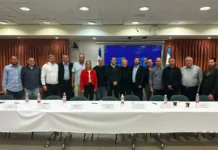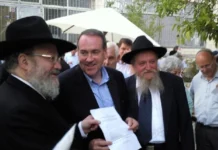Discovering Iraqi Mesorah: Reflections on an Exhibit
Fragments of a sefer Torah, open to Parashas Lech Lecha, a Gemara Maseches Yoma, a large sefer Tehillim — at least 18 inches tall — a religious guidebook for women written by the Ben Ish Chai, and a colorful, illustrated Haggadah shel Pesach are just some of the fascinating kisvei and sifrei kodesh available for viewing at the exhibit on Iraqi Jewish Heritage, currently open at the Jewish Museum of Maryland.
The exhibit, called “Discovery and Recovery: Preserving Iraqi Jewish Heritage,” details the dramatic recovery of historic materials relating to the Jewish community in Iraq from a flooded basement in Saddam Hussein’s intelligence headquarters, and the work of the National Archives to restore and conserve the materials.
Visiting the exhibit at the Jewish Museum of Maryland was a multifaceted experience — enlightening, inspiring and emotional. It was enlightening because there was much to learn about the history of the Jews in Iraq, their rich heritage, and the unshakable mesorah represented by these sefarim; inspiring, because seeing how this Jewish community, separated from the rest of the Jewish world for centuries, maintained their mesorah, reminded me of the nitzchiyus of Klal Yisrael; and emotional, because it was upsetting to see so many sefarim in such a state of disrepair, and consigned to an exhibit in a museum. Even more distressing than viewing the individual restored sefarim, was the sampling of pages of sefarim that were still stuck together in a moldy pile, most likely damaged beyond repair. While I could not make out most of the writing on the pages of this pile, partially because much of it was written in languages I do not recognize, I did notice a page from Yoreh Deah, Hilchos Treifus.
Discovery and Restoration
Text panels at the exhibit told the story. In May 2003, a United States Army team, searching for weapons of mass destruction, entered the flooded basement of Saddam Hussein’s intelligence headquarters. Amid four feet of water, they found 2,700 Jewish books, and tens of thousands of documents, dating from the mid-16th century to the 1970s. Many of the sefarim were printed in Baghdad in the 19th or 20th century, but many others were printed in other countries. These materials had been seized by Saddam Hussein’s Baath Party regime. Almost all of the recovered documents related to the Baghdad Jewish communal organizations, and are of particular importance when trying to understand Jewish communal life during the 1900s.
The search team, consisting of 16 American soldiers, began their attempt to salvage the materials from the floodwaters. However, in the hot and humid Baghdad weather, the wet artifacts quickly became moldy. The Coalition Provisional Authority in Iraq arranged to store the materials in a freezer truck to stop the mold growth. Meanwhile, the American soldiers requested help from the National Archives and Records Administration in Washington, D.C., which sent preservation experts to Baghdad. With the agreement of the Iraqi representatives, the books and documents were shipped in 26 metal trunks to the United States for preservation and exhibition.
Back in Washington, a highly skilled team of preservation experts at the National Archives got to work. After a vacuum freeze drying process, they unpacked the trunks, assessed the condition of the materials, and began the conservation process. Efforts included removing inactive mold by careful vacuuming, carefully separating water-damaged pages, and mending major tears in the paper. These efforts were rewarded with dramatic improvements in books and documents that seemed unsalvageable.
The items were then cataloged in order to create a proper inventory. In many cases, title pages and other key information were missing, making it necessary to conduct further research for proper identification.
The materials were digitized using state-of-the-art camera equipment specifically designed for imaging cultural heritage materials. Customized boxes were created for each individual item, using computerized box-making equipment, to permanently store each item. A list of all the materials — along with images — is now available on line at ija.archives.gov. Ultimately, the National Archives spent approximately $3 million on the restoration.
Mr. Marvin Pinkert, executive director of the Jewish Museum of Maryland, served as a curator of the National Archives during the years that the materials were being conserved and the exhibit put together. He commented, “The team did a marvelous job of rescuing records that we thought could not be salvaged. We had difficulty imagining how it could be brought back, but they did an incredible job.”

Other Highlights of the Exhibit
There was much more to see at the exhibit. There was a siddur printed in 1908 open to Yaaleh V’Yavo, and another siddur open to Selichos for Minchah. There was a Sefer Refuos, Sefer Sippur Nes Chanukah, a Seder Leil Shavuos, and a Zohar al HaTorah, printed in 1815 in Levorno, Italy (which was the primary center for the printing of Hebrew sefarim for Jewish communities in Arab lands, at that time).
There were also various letters and documents, granting a glimpse at Jewish life throughout the years. A letter, dated 1918, from the British Military Governor in Baghdad to the Chief Rabbi, allots 500 sheep to the Jewish community “for the celebration of the Jewish New Year.” A handbill, dated 1931, from the president of the City Council of the Baghdad Jewish Community, asked that the community members continue to pay taxes on kosher meat to support the schools, hospitals and charitable institutions.
Among the materials discovered by the soldiers were 200 ring binders, filled with letters, receipts, and records of life in Iraq. One binder at the exhibit displayed a wide variety of material — letters requesting immigration, a student’s chemistry notes, and a letter from the Chief Rabbi of Spanish and Portuguese Jews in Great Britain and Canada, asking for help in persuading a certain man who lived in Baghdad at the time to give his wife a get.
One of the artifacts included a Hebrew reading primer, named Alpha-Besa. The records indicated that 60 of these primers were found in the flooded basement. However, most were missing pages 73–74, which contained a Hebrew paragraph praising and declaring loyalty to King Faisal II. Most likely, after King Faisal II was overthrown in 1958, the pages needed to be removed from the primer, for the protection of the citizens.
It is worth noting that the sefarim that were displayed represent a small percentage of the sefarim that are archived and can be viewed through the exhibit’s website.

History of the Iraqi Jewish Community
The Iraqi Jewish community plays a central role in Jewish history and mesorah. Jews have been living in this area, previously known as Bavel, for thousands of years. The kevarim of many famous tzaddikim can be found there, including Daniel, Yechezkel, Ezra, and Yonah Hanavi. The land was also the origin of the Talmud Bavli, and the home of the great yeshivos of Sura and Pumpedisa. Jewish life thrived there continuously for thousands of years.
Records from 1910 show approximately 50,000 Jews living in Baghdad, which had a total population of just over 200,000. By 1949, an estimated 130,000 Jews lived in Iraq, primarily in Baghdad, Basra and Mosul. The Jewish community of Baghdad seemed to be well organized, with religious, educational and social institutions.
As the Nazis began to rise to power in Europe, their anti-Jewish propaganda spread to Iraq. On Shavuos 1941, an unprecedented attack took place on the Jewish community. For two days, the Jews were plundered and attacked. Ultimately, about 180 Jews were killed, hundreds were injured, and large numbers of homes and businesses were destroyed. Known as the Farhud, the attack shattered the Jews’ sense of safety and security.
In 1948, when Iraq entered the war against the newly founded State of Israel, the situation worsened for the Jews of Iraq, and many discriminatory laws were passed against them. In September 1948, a prominent Jew in Iraq was publicly executed, and Iraqi Jews rushed to leave the country, although that meant losing large amounts of assets. Operation Ezra and Nehemiah ensued, and during the years of 1950 to 1951, almost 120,000 Jews left Iraq. This operation, funded by the American Jewish Joint Distribution Committee, organized the mass emigration of Iraqi Jews to Israel, via Iran and Cyprus. Following the operation, about 10,000 Jews, a relatively small number, were left behind, in a country that had had a significant Jewish presence for 2,600 years.
Nevertheless, the small number of community members persisted and continued to function through the 1970s. Documents found in the flooded basement indicate a continuation of communal life in Baghdad, despite the dwindling numbers. However, the difficult times continued, and the community faced angry persecutions, especially after the rise of the Ba’ath Party in 1963. After the Six Day War in 1967, additional restrictions were placed upon the Jews. Jewish property was expropriated; bank accounts were frozen; Jews were dismissed from public posts, their businesses were closed; trading permits owned by Jews were canceled; they were not allowed to use telephones, were placed under house arrest for extended periods of time, and were under constant surveillance and restricted to the cities. In 1969, nine Jews falsely accused of spying for Israel were publicly hung. In the 1970s, due to international pressure, the Iraqi government allowed most of the remaining Jews to leave the country. When the United States Army entered in 2003, they found a mere 34 Jews in the entire country. Today, it is believed that the Jewish population of Iraq numbers less than five.
Should the Artifacts Be Returned to Iraq?
When the United States government removed the artifacts from Iraq in 2003, they promised to return them after preservation. Originally scheduled to be returned in 2014, the U.S. was allowed to keep them for another four years, until 2018. Now, with the deadline one year away, Senator Charles Schumer (D-N.Y.), is requesting that the State Department give them to the Jewish community instead. He explained that when the Jewish community fled Iraq, and were only allowed to carry one suitcase each, they were forced to leave these holy items behind. “This collection does not belong to the Iraqi government,” said Schumer. “It belongs to the ancient and proud Iraqi Jewish community — many now here in the States — that was exiled many years ago and forced to leave their belongings behind. After the United States preserved this ancient collection, it makes no sense to return the items to the Iraqi government, where they will no longer be accessible to the Jewish community. Therefore, I am once again urging the State Department to do everything in their power to ensure that these treasured artifacts remain available and accessible to Jews worldwide.”
There is much dispute as to whether the collection should be returned to Iraq. Pentagon official Harold Rhode, who was part of the archives rescue operation, told The Times of Israel that “International law states that you can’t take patrimony. When you take over a country, you can’t steal its treasures. On the other hand, the United States is holding millions of documents from the period when Hussein ruled. They are still in the United States. We are not giving them back.” But, says Rhode, “The Jews did not relinquish this material on their own will; they did it under duress, having no other option… We know how and we know when. They’re in a limbo now. Who can you give it back to? Will it be safe?”
Others feel the items should be returned for diplomatic reasons. Edwin Shuker, vice president of the European Jewish Congress, told Al-Monitor, “It is now important to open a dialogue between the Iraqi government and representatives of Iraqi Jews in a way that guarantees a fair agreement on the return of the archive to Iraq. It would reinforce the memory of Iraqi Jews and open the road for more cooperation concerning the material about the history of the community in Iraq to make available more of this material to exhibit before a larger audience.”


























